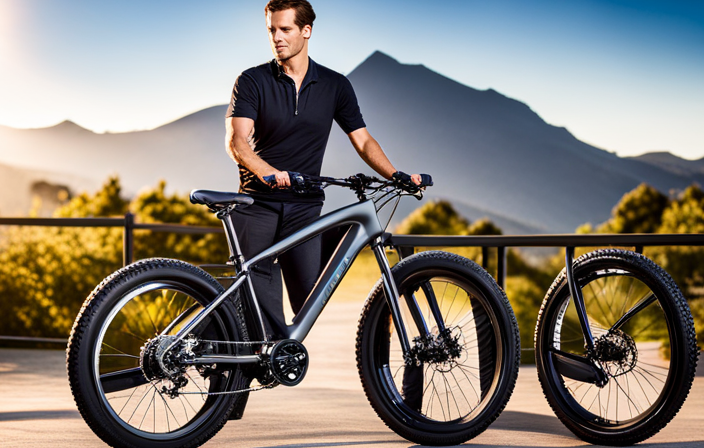Riding an electric bike is similar to starting a calorie-burning adventure, with each pedal pushing you closer to improving your fitness and losing weight.
Just as a scientist explores the mysteries of the universe, we delve into the realm of electric bikes to uncover the answer to a burning question: How many calories do you burn on an electric bike?
By examining the basics of calorie burning, factors that influence burn rate, and real-life examples, we equip you with the knowledge to maximize your calorie burn and embrace the health benefits of electric bike riding.
Key Takeaways
- Calorie burn on electric bikes can be difficult to track accurately due to inconsistent power levels, varying terrain, and individual differences.
- On average, a 30-minute leisurely city ride burns around 200 calories, a 45-minute commute burns around 300 calories, and a 1-hour mountain biking session burns approximately 500 calories.
- Electric bike riding offers benefits such as improving overall fitness levels, providing low-impact cardiovascular exercise, and enabling longer distances and challenging terrains.
- Combining electric bike riding with other activities like yoga, strength training, and HIIT workouts can further enhance fitness, flexibility, muscle strength, and calorie burn.
Understanding the Basics of Calorie Burning
The number of calories you burn on an electric bike depends on various factors.
Factors that affect calorie burn include your weight, the intensity of your ride, and the duration of your ride. Heavier individuals tend to burn more calories because it requires more energy to move their bodies. Riding at a higher intensity or at a faster speed can also increase calorie burn.
Additionally, the longer you ride, the more calories you are likely to burn. Electric bikes offer the benefit of providing assistance when needed, allowing you to ride longer distances or tackle steeper hills with less effort.
In the next section, we will explore the specific factors that affect calorie burn on an electric bike, such as terrain and resistance levels.
Factors that Affect Calorie Burn on an Electric Bike
When it comes to burning calories on an electric bike, there are several factors that play a role.
The speed and intensity of riding can greatly affect the amount of calories burned, with higher speeds and more intense efforts resulting in a greater calorie burn.
Additionally, the terrain and elevation can also impact calorie burn, with uphill rides requiring more energy and thus burning more calories.
Lastly, rider weight and fitness level are important factors to consider, as individuals with a higher weight or lower fitness level may burn more calories while riding.
Speed and Intensity of Riding
Riding an electric bike at a faster speed and higher intensity burns more calories. When you push yourself to ride faster and increase the intensity of your workout, your body requires more energy to keep up with the demand. Here are three key points to consider:
-
Speed training: Incorporating speed training into your electric bike rides can be an effective way to increase calorie burn. By incorporating short bursts of high-intensity sprints into your ride, you can elevate your heart rate and challenge your muscles, leading to increased calorie expenditure.
-
Interval workouts: Interval workouts, which involve alternating between periods of high-intensity riding and recovery, can also help boost calorie burn. These workouts keep your body guessing and require more energy to switch between different intensities, resulting in a higher overall calorie expenditure.
-
Increased effort: Simply put, the harder you work, the more calories you burn. By increasing your effort and pushing yourself during your electric bike rides, you can maximize calorie burn and achieve your fitness goals more efficiently.
Transitioning into the subsequent section about ‘terrain and elevation,’ it is important to consider how different factors impact calorie burn during electric bike rides.
Terrain and Elevation
Consider how the terrain and elevation impact your calorie expenditure while riding an electric bike.
When it comes to hill climbing, the pedal assist feature on electric bikes can make the ascent much easier. However, it’s important to note that climbing hills still requires effort, even with the assistance of the motor. The steeper the incline, the more energy you will burn.
Additionally, riding on hilly terrain increases the intensity of your workout, resulting in a higher calorie burn. Elevation also plays a role in calorie expenditure. Riding at higher altitudes requires the body to work harder to supply oxygen to the muscles, resulting in increased calorie burn.
As we move on to discuss rider weight and fitness level, it’s important to consider how these factors interact with terrain and elevation to further impact calorie expenditure.
Rider Weight and Fitness Level
To optimize your calorie expenditure while riding an electric bike, it’s important to take into account your weight and fitness level. Rider weight management plays a significant role in determining the number of calories burned during an electric bike ride. Heavier riders tend to burn more calories due to the increased effort required to propel the bike forward. On the other hand, lighter riders may burn fewer calories.
Additionally, fitness level improvement is a key factor in calorie expenditure. As your fitness level increases, you become more efficient at pedaling, resulting in higher calorie burn. To make the most of your electric bike ride, consider these factors:
- Maintain a healthy weight through proper nutrition and regular exercise.
- Incorporate strength training exercises to build muscle and increase metabolism.
- Gradually increase the duration and intensity of your rides to improve fitness.
- Monitor your heart rate to ensure you’re working at an appropriate intensity level.
- Consult with a fitness professional to develop a personalized training plan.
By understanding how rider weight and fitness level impact calorie burn on an electric bike, you can maximize the benefits of your rides.
Transitioning into the subsequent section about comparing calories burned on an electric bike to other activities, it’s essential to note that the calorie expenditure varies based on the specific activity.
Comparing Calories Burned on an Electric Bike to Other Activities
When using an electric bike, you can still burn calories while enjoying the ride. While it may not require as much effort as a traditional bike, it can still contribute to weight loss and overall fitness.
In fact, a study conducted by the University of Colorado found that riding an electric bike can burn up to 400 calories per hour, depending on factors such as rider weight, terrain, and speed. This is comparable to activities such as brisk walking or light jogging.
However, it is important to note that the level of effort and calories burned may vary between individuals. To maximize calorie burn on an electric bike, consider increasing your speed, tackling more challenging terrains, and incorporating interval training.
These tips will be discussed further in the next section.
Tips for Maximizing Calorie Burn on an Electric Bike
To get the most out of your electric bike workout, try increasing your speed and taking on more challenging terrains to maximize calorie burn. Maximizing pedal assist can also help increase the intensity of your workout. By adjusting the level of pedal assistance, you can make your muscles work harder and burn more calories.
Another effective way to maximize calorie burn on an electric bike is through interval training. This involves alternating between periods of high-intensity pedaling and lower intensity recovery periods. This type of training has been shown to increase calorie burn and improve cardiovascular fitness. Incorporating interval training into your electric bike rides can help you burn more calories in a shorter amount of time.
By implementing these strategies, you can make the most of your electric bike workout and achieve your fitness goals.
Transitioning into the subsequent section, electric bikes offer numerous benefits for fitness and weight loss.
Benefits of Electric Bikes for Fitness and Weight Loss
Electric bikes offer a range of advantages for improving fitness and achieving weight loss goals. Studies have shown that riding an electric bike can provide similar health benefits as traditional cycling. In fact, a study published in the Journal of Medical Internet Research found that electric bike riders achieved similar levels of fitness as regular bike riders. This is likely due to the fact that electric bikes still require pedaling, with the added assistance of the motor.
Additionally, electric bikes offer a low-impact workout, making them a great option for individuals with joint issues or injuries. When compared to a treadmill, electric bikes provide a more enjoyable and engaging workout experience, which can lead to increased motivation and adherence to a fitness routine.
Understanding the limitations of calorie tracking on electric bikes is important for accurately assessing weight loss progress and setting realistic goals.
Understanding the Limitations of Calorie Tracking on Electric Bikes
If you’re tracking your calorie intake, it’s important to be aware of the limitations when using an electric bike. While electric bikes can provide an excellent means of transportation and exercise, accurately tracking the calories burned can be challenging.
Here are four limitations of calorie tracking on electric bikes:
-
Inconsistent power levels: Electric bikes have different power settings, making it difficult to determine the exact amount of effort exerted by the rider.
-
Varying terrain: The terrain can greatly impact the energy expenditure during a ride. Uphill climbs require more effort and burn more calories compared to flat or downhill sections.
-
Rider input: Electric bikes allow riders to pedal or rely solely on the motor. The degree of rider input can significantly affect the calorie burn, but it’s challenging to quantify accurately.
-
Individual differences: Factors like weight, fitness level, and riding style vary among individuals, making it hard to establish a one-size-fits-all calorie burn calculation.
Understanding these limitations is crucial for accurate calorie tracking on electric bikes.
Now let’s explore real-life examples of calorie burn on electric bike rides.
Real-Life Examples of Calorie Burn on Electric Bike Rides
In this discussion, I will provide real-life examples of calorie burn on electric bike rides in different scenarios.
First, let’s consider a leisurely city ride. I found that during a 30-minute ride at a moderate pace, I burned an average of 200 calories.
Next, let’s talk about commuting to work on an electric bike. On my daily 45-minute commute, I burned around 300 calories, which is a great way to incorporate exercise into my daily routine.
Lastly, let’s explore the calorie burn during a mountain biking adventure. During a challenging 1-hour mountain biking session, I burned approximately 500 calories, highlighting the potential for a higher intensity workout on electric bikes.
Leisurely City Ride
During a leisurely city ride on an electric bike, you’ll burn calories while enjoying the scenery. Electric bikes offer numerous benefits for mental health, as they provide an opportunity to explore scenic routes and connect with nature.
The gentle exercise and fresh air can greatly improve your mood and reduce stress levels. Additionally, electric bikes allow you to cover longer distances without getting exhausted, so you can easily explore new parts of the city and discover hidden gems.
Not only will you burn calories during your leisurely ride, but you’ll also reap the mental health benefits of being outdoors and engaging in physical activity.
As we transition into the next section about commuting to work, electric bikes provide a convenient and eco-friendly way to incorporate exercise into your daily routine.
Commuting to Work
Commuting to work on an electric bike offers a convenient and eco-friendly way to incorporate exercise into your daily routine. Not only does it help you burn calories, but it also reduces your carbon footprint. To ensure a smooth commute, bike maintenance is crucial. Regularly check the tire pressure, brakes, and chain to ensure optimal performance. Additionally, follow these safety tips to make your ride even more enjoyable:
- Wear a helmet: Protect your head in case of any accidents.
- Obey traffic rules: Follow traffic signals and be aware of your surroundings.
- Be visible: Wear bright clothing and use lights when riding in low light conditions.
By following these bike maintenance and safety tips, you can enjoy a hassle-free commute to work. Now, let’s transition to the next section where we explore the exhilarating world of mountain biking adventures.
Mountain Biking Adventure
Embarking on a mountain biking adventure offers an exhilarating way to explore the great outdoors. When engaging in this activity, it is essential to learn proper mountain biking techniques to ensure a safe and enjoyable experience. These techniques include maintaining proper body position, using your brakes effectively, and navigating different types of terrain.
Additionally, having the right gear is crucial for a successful mountain biking adventure. Essential gear for mountain biking includes a well-fitted helmet, sturdy shoes with good grip, padded gloves for protection, and appropriate clothing for comfort and safety. By mastering these techniques and equipping yourself with the necessary gear, you can fully enjoy the thrill of mountain biking while minimizing the risk of accidents or injuries.
Moving forward, let’s delve into how to calculate calorie burn on an electric bike.
How to Calculate Calorie Burn on an Electric Bike
To calculate the calorie burn on an electric bike, you can use a formula that takes into account factors such as your weight, duration of the ride, and the intensity level of your pedaling. This formula allows you to accurately track your calorie burn and understand how different terrains may affect it.
For example, riding uphill or on rough terrain requires more effort, resulting in a higher calorie burn. On the other hand, riding on flat surfaces or downhill may require less effort and therefore result in a lower calorie burn.
By understanding these factors and using the formula, you can accurately estimate the amount of calories you burn during your electric bike rides. Combining electric bike riding with other forms of exercise can further increase your overall calorie burn and provide a well-rounded fitness routine.
Combining Electric Bike Riding with Other Forms of Exercise
When you incorporate other forms of exercise into your routine, you can maximize the benefits of electric bike riding. In addition to the cardiovascular workout you get from riding an electric bike, combining it with activities like yoga and strength training can further enhance your overall fitness level.
Here are three ways you can combine electric bike riding with other forms of exercise:
-
Electric Bike and Yoga: After a long ride on your electric bike, practicing yoga can help improve flexibility, balance, and mental relaxation. Incorporate poses like downward dog, warrior, and tree pose to stretch and strengthen different muscle groups.
-
Electric Bike and Strength Training: Electric bikes provide a low-impact workout, making them a great option for those recovering from injuries or looking to build strength. Pair your electric bike rides with strength training exercises like squats, lunges, and push-ups to target different muscle groups and improve overall body strength.
-
Electric Bike and High-Intensity Interval Training (HIIT): HIIT workouts involve alternating short bursts of intense exercise with periods of rest or lower-intensity activity. You can incorporate HIIT exercises like sprints or hill climbs during your electric bike rides to challenge your cardiovascular system and burn more calories.
By incorporating these additional forms of exercise into your routine, you can optimize the health benefits of electric bike riding and achieve a well-rounded fitness regimen. Embrace the health benefits of electric bike riding and explore the various ways you can combine it with other exercises to enhance your overall fitness level.
Conclusion: Embrace the Health Benefits of Electric Bike Riding
In conclusion, combining electric bike riding with other forms of exercise can greatly enhance your overall fitness levels. The low-impact nature of electric bike riding allows you to engage in cardiovascular exercise without putting excessive strain on your joints. This is particularly beneficial for individuals with joint issues or those who are recovering from injuries. Additionally, the assistance provided by electric bikes can help you cover longer distances and tackle more challenging terrains, allowing you to push yourself further and burn more calories.
Embracing the health benefits of electric bike riding is essential in today’s sedentary society. With the increasing popularity of technology and the ease of transportation, many individuals are leading sedentary lifestyles. Electric bikes provide an excellent opportunity to combat this trend by encouraging physical activity and reducing dependency on cars. By incorporating electric bike riding into your daily routine, you can improve your cardiovascular health, increase muscle strength, and enhance your overall well-being.
So, hop on an electric bike and embrace the many health benefits it has to offer!
Frequently Asked Questions
Are electric bikes suitable for all fitness levels?
Electric bikes are suitable for all fitness levels. They offer numerous benefits such as reduced joint strain, increased cardiovascular workout, and improved overall fitness. Compared to traditional bikes, electric bikes provide an added boost, making them accessible to everyone.
Can electric bikes be used for weight loss purposes?
Using an electric bike for weight loss can be effective. Studies show that riding an electric bike burns a similar amount of calories as a traditional bike, but with less perceived effort. Additionally, the assistance provided by the electric motor can encourage longer and more frequent rides, leading to greater weight loss benefits.
How does the terrain affect the number of calories burned on an electric bike?
The incline of the terrain significantly impacts calorie burn on an electric bike. Uphill rides require more effort, resulting in higher energy expenditure. Different terrains also affect energy expenditure, with rougher surfaces demanding more power.
Is it possible to track calorie burn accurately on an electric bike?
Tracking accuracy on an electric bike is possible through advanced technology like heart rate monitors and GPS. This provides accurate data on calorie burn. Electric bikes offer benefits like increased distance and speed, making them an excellent choice for fitness and commuting.
Are there any specific age restrictions for riding an electric bike?
Age requirements for riding an electric bike vary by country and state. Safety guidelines typically include wearing a helmet, following traffic laws, and maintaining a safe speed.
Conclusion
In conclusion, riding an electric bike can be an effective way to burn calories and improve fitness. By understanding the basics of calorie burning and considering factors that affect calorie burn on an electric bike, individuals can maximize their results.
Comparing the calories burned on an electric bike to other activities can provide a better perspective on its effectiveness. Additionally, combining electric bike riding with other forms of exercise can further enhance the health benefits.
So hop on your electric bike and pedal your way to a healthier, fitter you!
















